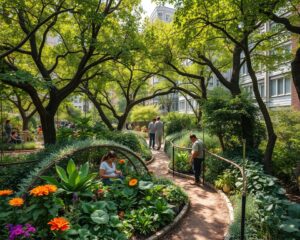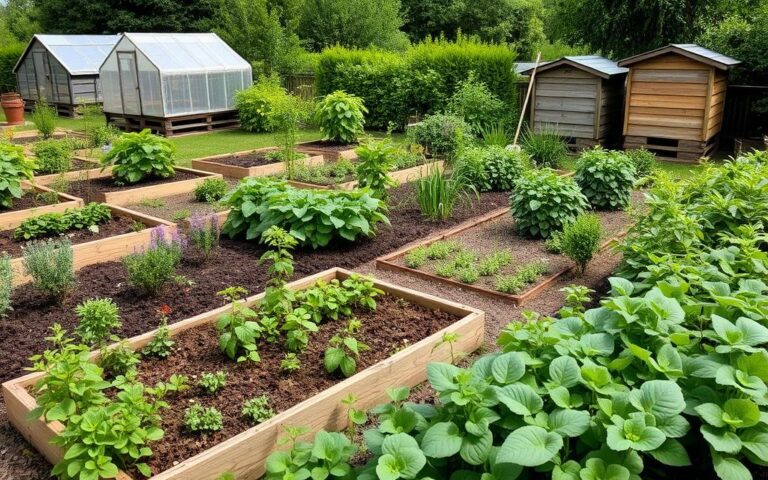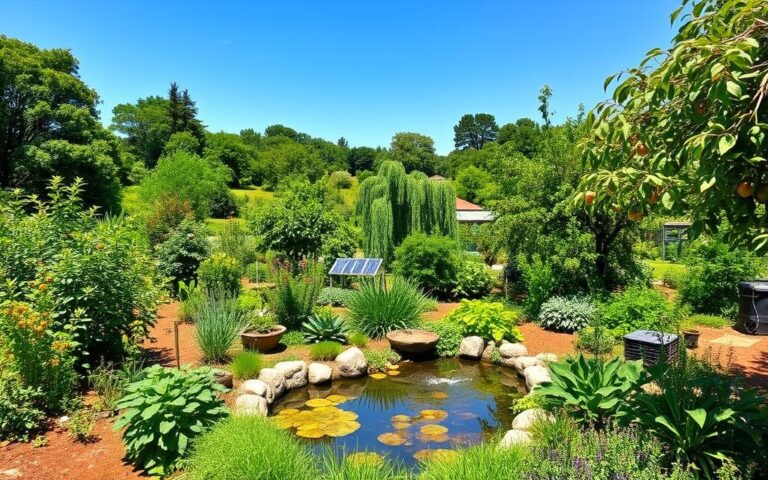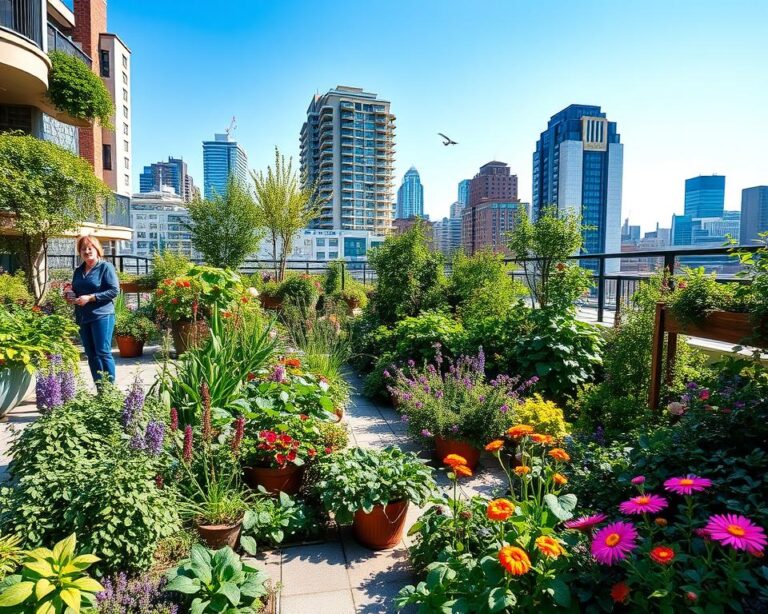Did you know 16% of the world’s people face chronic hunger? In the U.S., we throw away about 90 kg of food per person every year. Urban permaculture is a growing hope for cities. It uses food forests and sustainable farming to fight hunger, boost biodiversity, and build stronger communities.
The Sherrett Food Forest in Portland, Oregon, was once empty land. Now, it’s a lush spot with over a hundred food types, thanks to students. The Beacon Food Forest in Seattle is another example. It shows how cities can be used for community and nature.
By using nature’s design, we can grow food, connect with neighbors, and make cities greener. Start your own food forest and join the urban permaculture movement. It’s a chance to make a difference in your community!
What Are Food Forests?
Food forests are a new way to grow food in cities. They look like a forest but are full of edible plants. This approach to farming is all about living sustainably and growing a variety of food.
Definition and Key Characteristics
A food forest has different layers of plants. You’ll find trees, shrubs, herbs, and ground cover. Each layer works together to help the farmer and create a balanced ecosystem. Here are the main layers:
- Canopy Layer: The biggest trees are at the top. They give shade to the plants below.
- Mid-Canopy Layer: This layer has shorter trees like apples and cherries.
- Lower Canopy Layer: Here, you’ll find smaller shrubs like blueberries and raspberries.
- Non-Woody Plants: Asparagus, garlic, and herbs add to the food variety.
- Ground Cover Crops: Plants like creeping rosemary and strawberries keep the soil in place.
- Vines: Grapes and beans grow up and add beauty and food.
- Root Crops: Vegetables like potatoes help keep the soil stable.
Benefits of Food Forests for Communities
Food forests are great for community gardens and living sustainably. They help grow fresh food and increase local wildlife. They also bring people together and teach about nature. The main benefits are:
- Improved Food Security: People get to eat fresh, healthy food, not just what’s in stores.
- Community Engagement: Working together makes people feel proud and connected.
- Enhanced Biodiversity: Many plants attract good bugs and animals, making the ecosystem strong.
- Low Ecological Footprint: They use less chemicals, making the environment healthier.
Food forests do more than grow food. They turn cities into strong, green places where communities can thrive.
The Principles of Permaculture Design
Learning about permaculture design is key to making sustainable systems. These systems respect the environment and help communities become stronger. By using ecological principles, you can improve soil and society.
Understanding Permaculture Ethics
Permaculture design is based on three main ethics: Care for the Earth, Care for People, and Fair Share. These ethics help us work with nature and care for our communities. They ensure that both ecosystems and people can thrive together.
Core Principles to Consider
Using permaculture design principles can change how you farm. These include:
- Observing natural patterns: Learning from nature helps make better decisions.
- Cycling resources: Reusing materials reduces waste and boosts sustainability.
- Integrating plant species: Different plants working together fight pests and diseases.
- Valuing diversity: A variety of plants makes ecosystems strong and healthy.
- Adapting to change: Being flexible lets your design grow with new situations.
Applying these principles makes your farm or garden vibrant and healthy. It nourishes the environment and your community. Whether it’s a small garden or a big project, permaculture brings many benefits.
| Principle | Description | Benefit |
|---|---|---|
| Observe and Interact | Take time to engage with your environment. | Improves understanding of ecological dynamics. |
| Catch and Store Energy | Use renewable energy sources well. | Reduces need for outside power. |
| Use and Value Renewables | Choose sustainable materials and energy. | Lessens ecological impact. |
| Produce No Waste | Design to reduce waste. | Boosts resource use and sustainability. |
| Integrate Rather Than Segregate | Encourage good relationships between species. | Creates balanced ecosystems with less input. |
How to Start a Food Forest in Your Community
Starting a Food Forest in your community is rewarding and enriching. It supports sustainable gardening and brings people together. By following key steps, you can create a food forest that benefits everyone.
Assessing Available Space
First, look for places in your community where Food Forests can grow. Think about vacant lots, school yards, or parks. Check the climate, soil, and plants in your chosen spot.
Use earthworks to manage water. This includes swales or ponds to keep water in the soil, especially in clay areas.
Choosing the Right Plants
Picking the right plants is key for a successful food forest. Choose native and perennial plants that fit your local climate. Good options include devil’s claw, prickly pear, jujube, and fig.
Visit local nurseries to find plants that do well in your area. Layering plants over time helps build a strong ecosystem.
Engaging Community Members
Getting the community involved is crucial for a food forest’s success. Host workshops and design sessions to build connections. Encourage people to share their gardening skills.
Start volunteer programs for hands-on learning. This helps people invest in the forest’s care. A dedicated community is essential for the forest’s long-term success.
| Step | Action | Benefits |
|---|---|---|
| 1 | Assess available space | Identifies potential sites for planting |
| 2 | Choose right plants | Supports biodiversity and local ecosystem |
| 3 | Engage community members | Enhances participation and ownership |
Benefits of Food Forests for Urban Environments
Food forests bring many benefits to cities. They help solve big problems like sustainability, biodiversity, and health. These forests add green spaces, helping restore ecosystems and support wildlife.
Enhancing Biodiversity
Food forests make cities more diverse. They attract pollinators, birds, and insects. The mix of trees, shrubs, and ground cover creates homes for many animals.
This diversity is good for the environment. It helps keep ecosystems healthy in crowded areas.
Improving Air and Soil Quality
Food forests clean the air. Plants absorb pollutants, making the air better for people. They also release oxygen, which is good for breathing.
The roots of plants stop soil erosion. They also filter rainwater, improving water quality. This reduces flood risks. Organic gardening in food forests keeps the soil healthy, supporting long-term sustainability.
Creating a Sustainable Food Source
Food security is key in today’s world. We need to focus on sustainable food systems. This ensures we always have fresh food and helps our environment. Using year-round harvesting strategies can also make the most of our space.
Year-Round Harvesting Strategies
To have food all year, try these harvesting tips:
- Succession Planting: Plant different crops in the same spot at different times for a steady supply.
- Keyhole Gardening: This method uses space well and makes it easy to reach your plants.
- Seasonal Rotation: Change your crops with the seasons to keep the soil healthy and yields high.
Companion Planting Techniques
Companion planting boosts yields and supports food security. It pairs plants in a way that helps each other. Here’s why it’s good:
- Pest Control: Some plants keep pests away, cutting down on chemical use.
- Nutrient Uptake: Plants can make the soil better, helping others grow stronger.
- Microclimate Creation: Taller plants protect smaller ones, making a better growing space.
Using these methods helps our food systems and builds strong communities. We can rely less on outside food sources.
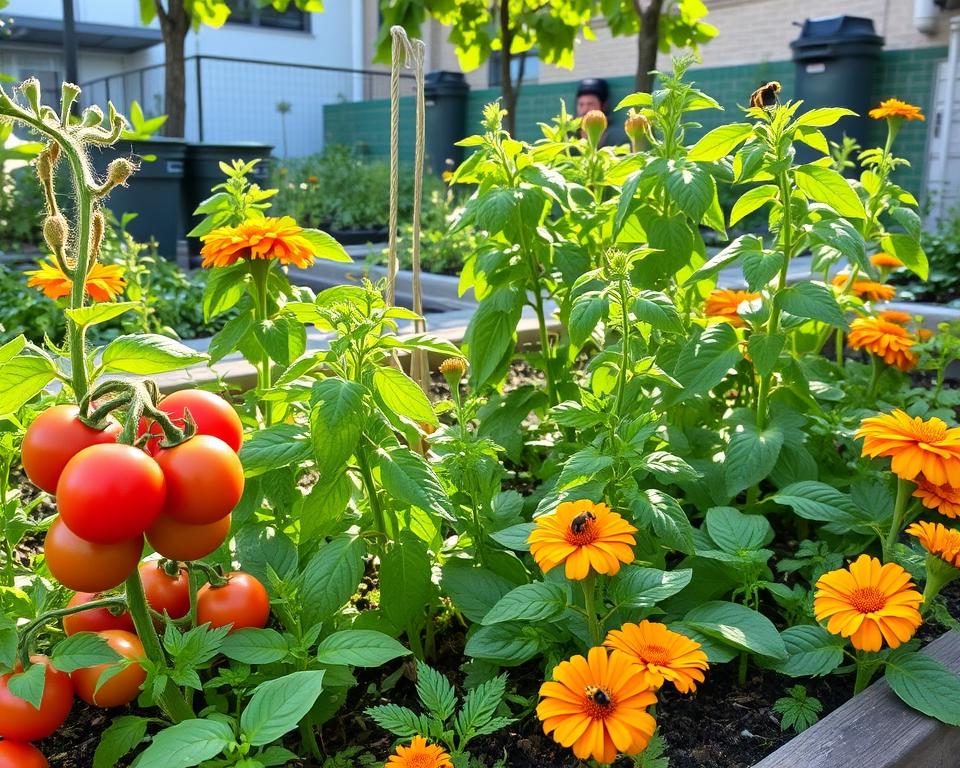
| Technique | Description | Benefit |
|---|---|---|
| Succession Planting | Plant new crops right after harvesting others. | Keeps food coming all year. |
| Keyhole Gardening | A circular garden for easy access. | Uses space well and saves work. |
| Companion Planting | Grows plants that help each other. | Helps with pests and nutrient use. |
Engaging Local Schools and Community Programs
Getting local schools and community programs involved in food forests is a great way to learn and bond. These projects help people connect with nature and learn about sustainability. They also make the community stronger.
Educational Opportunities through Food Forests
Food forests are perfect for teaching kids about the environment. They introduce students to important topics like ecology and sustainability. This way, kids learn by doing and get to work together.
- Practical learning experiences that reinforce classroom lessons.
- Teamwork opportunities as students collaborate on planting and maintenance activities.
- Understanding biodiversity by studying various plant species and their interrelationships.
Volunteer Programs for Community Involvement
Volunteer programs in food forests let people get involved. They make everyone feel like they belong and are working together. Here are some ways to get people involved:
- Organizing community planting days where residents contribute to creating and sustaining food forests.
- Hosting workshops that teach gardening techniques and permaculture practices.
- Encouraging participation in the ongoing maintenance of food forests, ensuring consistent community engagement.
Working together, schools and community programs can make a big difference. They help urban areas grow and improve. Food forests become places where people can thrive and care for the environment together.
Transforming Underutilized Spaces
Urban revitalization often involves turning underused areas into something new. Finding the right spots is key. Vacant lots, rooftops, and community parks can become lively green spaces. This effort boosts community spirit and helps the environment by using land better.
Identifying Potential Locations
Begin by looking around your neighborhood for places that could use a makeover. Search for:
- Vacant lots that are not actively used.
- Parks or school grounds that could host community gardens.
- Rooftops of buildings that can be transformed into green spaces.
These spots offer chances to create beautiful areas. They improve community health and support nature.
Steps for Repurposing Land
Repurposing land requires a few important steps:
- Secure permissions: Get the okay from local authorities for land use.
- Assess site conditions: Check soil, sunlight, and water to help plants grow.
- Engage community members: Get locals involved in planning and doing through meetings or workshops.
Getting people involved makes these projects stronger. It also gives residents a sense of pride in their new green spots.
Long-Term Maintenance and Care
Keeping a food forest healthy needs constant care. Using sustainable methods helps it thrive. This way, everyone involved feels connected and responsible for the space.
Sustainable Practices for Food Forest Maintenance
Using sustainable methods is key for your food forest’s health. Here are some practices to consider:
- Mulching: Keeps the soil moist and stops weeds, making upkeep simpler.
- Crop rotation: Stops soil from getting worn out and boosts plant variety.
- Organic composting: Fertilizes the soil naturally, making it healthier.
- Efficient water management: Using drip irrigation or rainwater catchment saves water.
- Regular harvesting: Encourages more growth and gives fresh food to the community.
Community Involvement in Care
Getting the community involved is crucial for a food forest’s success. Local volunteers help create a sense of belonging. Regular clean-up events build friendships and keep the forest in good shape. Here’s how to get the community involved:
- Host workshops: Teach about sustainable gardening and seasonal tasks.
- Establish volunteer days: Organize events for hands-on work.
- Encourage educational programs: Work with schools to teach about gardening and ecology.
| Practice | Description | Benefits |
|---|---|---|
| Mulching | Applying organic material to the soil surface. | Retains moisture, suppresses weeds, enhances soil health. |
| Crop Rotation | Changing the types of crops grown in specific areas. | Reduces pests and diseases, improves nutrient availability. |
| Organic Composting | Decomposing organic matter to enrich the soil. | Improves soil structure, promotes beneficial microbial activity. |
| Efficient Water Management | Utilizing systems like rainwater catchment. | Conserves water while supplying necessary moisture to plants. |
| Regular Harvesting | Collecting ripe produce consistently. | Promotes ongoing fruit and vegetable production, enhances flavor. |
Success Stories from Cities Across the U.S.
Cities across the United States are using community-led initiatives to change urban areas. These efforts, like food forests, inspire others. They create green spaces that help with food access and support nature.
Case Study: Los Angeles Food Forest Initiative
The Los Angeles Food Forest Initiative is a great example of success. People from different neighborhoods worked together. They turned unused land into green spaces full of food.
This project helped make food more available and brought people together. Volunteers from all over helped create a network of gardens. Now, these gardens give fresh food to local families.
Case Study: New York City Urban Gardens
New York City’s gardens show the power of community work. People came together to make public spaces better. They created gardens that give fresh food and strengthen community bonds.
One big project is Swale, a floating garden on a barge. It helps those in food deserts get healthy food. This shows how community efforts can make a big difference in the city.
The Future of Food Forests in Urban Planning
As cities grow, we need sustainable solutions fast. Food forests are key, linked to policy changes for urban farming. By supporting local food, cities can weave food forests into their landscapes. This changes how we see and use our surroundings.
Policy Changes to Support Urban Agriculture
Local governments must change rules to help food forests grow. They need to adjust zoning, offer funding, and make it easy for communities to start projects. Working together, cities and residents can make food forests a part of city life.
This teamwork leads to more green spaces. It improves food security and makes communities stronger.
The Role of Local Governments in Food Forests
Local governments are crucial for food forests in cities. They can support food justice and urban farming in city plans. This creates a good environment for food forests.
Strategic plans can also make it easier for people to get involved. This way, you can help make your city greener and more beautiful. Food forests are important for healthy ecosystems and happy communities.

